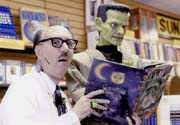While wandering the long halls of the main public library in Jersey City, watch out for the thousands of images of Frankenstein hanging on the walls and from the ceilings. Some of them look mighty scary, and others not so much.
In December, award-winning Frankenstein collector and historian Ron MacCloskey will dress up as Dr. Frankenstein and perform for children and their parents visiting the library. This is part of the library’s exhibit, "Frankenstein: Penetrating the Secrets of Nature," which runs now through Jan. 6 on the fourth floor showcase room.
"He will frequent the library many times to answer questions about the book. His memorabilia and tidbits on Frankenstein will amaze you," said library spokeswoman Michele Dupey. "It’s everything you wanted to know about Frankenstein but were afraid to ask."
Since introducing the novel Frankenstein: The Modern Prometheus in 1831 to the world, author Mary Shelley depicted a gloomy picture of the possibility of resurrecting people through electricity. More than 100 years after the release of the book, American cinema adapted the story for the big screen, and the image and concept of Frankenstein evolved into a scary Halloween icon.
"The exhibit helps spark dialogues about modern science ethics and direction," said Sonia Araujo, the library’s project director.
The traveling exhibit, which will make its way to 40 libraries during the next two years as part of the American Library Association, encourages audiences to examine the intent of Shelley’s novel, and to discuss how the novel relates to modern science and other areas of life.
The exhibit featured a lecture by Dr. Susan Levin, a professor of humanities at Stevens Institute of Technology in Hoboken, during the opening reception held Nov. 18.
"The exhibit also addresses issues such as cloning and genetic engineering, which raise questions about the human implications of scientific and technological advances that are troubling to many," Levin said. "The story of Frankenstein can help the public to articulate and examine these fears."
About Frankenstein
Shelley was 18 when she began writing the book about Frankenstein. She was the daughter of a social reformist, and believed knowledge was a defense against the abuse of power by governments and individuals, according to a biography of her posted on the exhibit.
After studying the natural sciences and social politics, Shelley created her protagonist, Dr. Victor Frankenstein, whose personal ambition to reveal the secrets of nature lead to his death and the destruction of his community.
Dr. Frankenstein’s monster was lonely, articulate and sensitive. The monster lashed out in revenge when he was betrayed and abandoned by his maker.
Throughout the decades, the monster has been a symbol for fears about cutting-edge scientific techniques and research that often challenged the public’s understanding of what is "natural" and what it means to be human, according to Dupey.
"Frankenstein is frequently mentioned in media accounts of developments such as cloning, gene manipulation, and organ transplants," Dupey said.
"Penetrating the Secrets of Nature," developed by the National Library of Medicine, has been made possible by major grants for the National Endowment for the Humanities and the National Library of Medicine.
The library is located at 472 Jersey Ave. It is open Monday and Tuesday from 10 a.m. to 6 p.m., Wednesday and Thursday from 12 p.m. to 7 p.m., and Saturday from 10 a.m. to 4 p.m. For information call visit www.jclibrary.org. Check the library’s listings for a schedule of MacCloskey’s performances.
